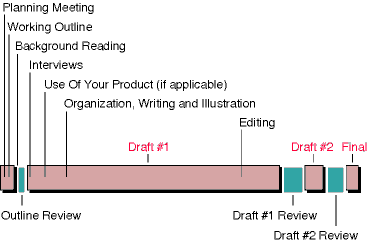|


How We Write a
Technical Document
Projects typically begin with the signing a nondisclosure
agreement and meetings or conference calls to assemble source
documents. We then develop a working outline.

The timeline above represents a typical large project (several hundred pages). Our working time
appears in red. Your review time appears in green. The sum of the
red areas represents our total working
time. The entire width of the timeline represents the project's total
elapsed time. Draft 1 usually occupies the large majority
of time and work—sometimes more than 90% of the total. The
remaining drafts can usually be completed quickly after return of
Draft 1 comments.
Each draft typically looks like a final draft, with professional formatting and figures. You own the
copyright to all drafts.
We can start on a small part of your project and show you the result. This will let you experience the
quality, pace, and style of our work before we proceed with larger parts of your project.
Document content is assembled from many sources, including engineering specifications, interviews with your
product designers, patents, industry standards and journals, articles and documents on current and prior
art, Internet websites, and our existing knowledge of
your technology. If applicable,
we may also use your product to experience it the same way your customers experience it. We try to
anticipate, and answer, the questions your customers will have.
We normally begin by reading
your engineering specifications.
In doing this, we not only gain an understanding of your product but we also identify inconsistencies and
missing parts in your specifications. We generate notes that form the basis for interviews
and the beginning of our writing.
We conduct interviews with your product architects, circuit and software developers, and product managers.
We follow up with questions by email and telephone.
When we understand your product and your customers' needs, we begin
writing and illustrating. During the writing, we focus
on clear organization, accuracy, consistency of terminology, and completeness.
We write using industry-standard terms, so
that readers who have learned English as a second language can understand
it quickly. We create tables and cross-references that help readers random-access into the content quickly.
And
we observe laws protecting trademarks and copyrights.
We use editing tools including Word, FrameMaker, XML, and PowerPoint for writing. We use graphics tools
including Visio, Illustrator, and PowerPoint for illustration. We save drafts in Adobe Reader or Acrobat for
internal review and posting on your website.
|